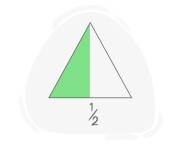Matematika a Hodnocení ACT - Aritmetika a statistika
Zde se naučíte některá anglická slova související s aritmetikou a statistikou, jako je "odhad", "medián", "dělitelný" atd., která vám pomohou uspět u vašich ACT.
Revize
Kartičky
Pravopis
Kvíz

any number without fractions or decimals, including positive numbers, negative numbers, and zero

celé číslo
a number obtained by dividing one integer or rational number by another, typically written in the form a/b

zlomek, obyčejný zlomek
(mathematics) a number less than one, called a fraction, that is represented as a period followed by the number of tenths, hundredths, etc.

desetinné číslo, desetinný zlomek
(mathematics) the average value of a set of quantities calculated by adding them, and dividing them by the total number of the quantities

průměr, aritmetický průměr
calculated by adding a set of numbers together and dividing this amount by the total number of amounts in that set

průměrný
a combination of a whole number and a proper fraction

smíšené číslo, smíšený zlomek
a number greater than 1 with only two devisors which can be itself or 1

prvočíslo
a number that can be written as a fraction, where both the top and bottom are whole numbers, and the bottom is not zero

racionální číslo, racionální zlomek
a number incapable of being expressed as a ratio of two integers

iracionální číslo, nesouměřitelné číslo
a number that has both a real part and a part involving a unit that, when squared, gives a negative result

komplexní číslo, komplexní
any number that can be found on the number line, including both positive and negative numbers, zero, and fractions

reálné číslo, reálné
any positive number without fractions or decimals, including zero

celé číslo, přirozené číslo
a value that, when multiplied by itself a specified number of times, results in the given number

kořen, radikál
the difference between the highest and lowest values in a set of numbers

rozsah, rozpětí
a correct answer to a problem in mathematics or a puzzle

řešení, odpověď
the result of multiplying two or more numbers or quantities together

součin, výsledek násobení
(mathematics) one of the numbers that another number can be divided by

činitel
(mathematics) an amount that is shown by a sign or letter

hodnota, množství
a statement that compares two quantities, expressions, or values and indicates their relative sizes

nerovnost
(mathematics) a statement indicating the equality between two values

rovnice
having the least or smallest amount possible

minimální, nejmenší
a mathematical expression where a number is multiplied by itself a certain number of times determined by a variable

exponenciála, exponenciální funkce
a sequence of numbers in which the difference between any two consecutive terms is constant

aritmetická posloupnost, aritmetická sekvence
to multiply a value or number by itself

umocnit na druhou, násobit sebou samým
a fraction where the the top number is greater than or equal to the equal to the bottom number

nepravý zlomek
the result obtained by dividing one quantity or number by another, expressed as the outcome of a division operation

podíl
the constant ratio between consecutive terms

společný poměr, konstantní poměr
a number that is a multiple of two or more given numbers

společný násobek, společný násobitel
a number that divides exactly into two or more given numbers without leaving a remainder

společný činitel, společný dělitel
(mathematics) a number divisible by all the numbers that are below the line in a set of fractions

společný jmenovatel, jmenovatel společný
the smallest positive integer that is a common multiple of the denominators of two or more fractions

nejmenší společný jmenovatel, nejmenší společný dělitel
(mathematics) a number representing the chances of something specific happening

pravděpodobnost
a statistical measure that represents the middle value of a data set when the values are arranged in ascending or descending order

medián, střední hodnota
having or involving two distinct modes, peaks, or most frequent values

bimodální, s dvěma režimy
to guess the value, number, quantity, size, etc. of something without exact calculation

odhadnout, posoudit
the number of times a particular event occurs within a specific period or among a set of observations

frekvence
(statistics) an arrangement of values of a variable showing how often each occurs, either observed or theoretical
a measure of how much the values in a set typically differ from the average

směrodatná odchylka, standardní odchylka
the range within which the true value is expected to fall, accounting for potential inaccuracies in measurement or sampling

míra chyby, rozpětí chyby
occurring in such a way that each possible outcome has a certain probability of occurring, but the specific outcome cannot be predicted with certainty

náhodný, libovolný
a straight line drawn through a set of data points on a graph to represent the general direction or pattern of the data

trendová čára, čára tendence
a type of statistical chart consisting of dots that represent individual data points

bodový graf, tečkový diagram
a mathematical representation that describes the relationship between two or more variables using a linear equation

lineární model, model lineární regrese
| Matematika a Hodnocení ACT | |||
|---|---|---|---|
| Matematika | Aritmetika a statistika | Geometry | Množství a Partitivy |
| Economics | Čas a Pořádek | Proces Akcí | Stipendium a Inovace |
| Zařazení a Klasifikace | Comparison | Importance | Praise |
| Hodnocení a Kritika | Change | Status | Správa položek |







